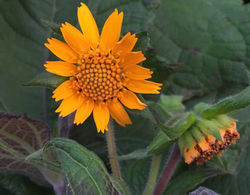 Our yacon young plants and varieties represent a new vegetable species in the assortment group 'Fruits of the Roots®'. We will be able to offer you yacon young plants starting in spring 2021. As with potatoes and oca, yacon is a plant species with edible tubers that originated in South America, in the highlands of the Andes, and was already cultivated by the Incas. Although yacon has almost no relevance in commercial cultivation in Europe, it is an interesting plant and an even more interesting vegetable. In the following text, let yourself be surprised and inspired by this old but at the same time new vegetable plant.
Our yacon young plants and varieties represent a new vegetable species in the assortment group 'Fruits of the Roots®'. We will be able to offer you yacon young plants starting in spring 2021. As with potatoes and oca, yacon is a plant species with edible tubers that originated in South America, in the highlands of the Andes, and was already cultivated by the Incas. Although yacon has almost no relevance in commercial cultivation in Europe, it is an interesting plant and an even more interesting vegetable. In the following text, let yourself be surprised and inspired by this old but at the same time new vegetable plant.
Yacon – botany and appearance
Botanically, the genus Smallanthus belongs to the daisy family (Asteraceae) and is thus a relative of sunflowers/Jerusalem artichoke, dahlias and a variety of other edible plants as well as ornamental plants. Generally speaking, yacon and sunflowers already look quite similar. The close relationship can be seen particularly well during the time of flowering. However, the yellow and orange colours of the approximately 10 cm large flowers appear only very late in the year, usually so late that obtaining seeds is almost impossible.
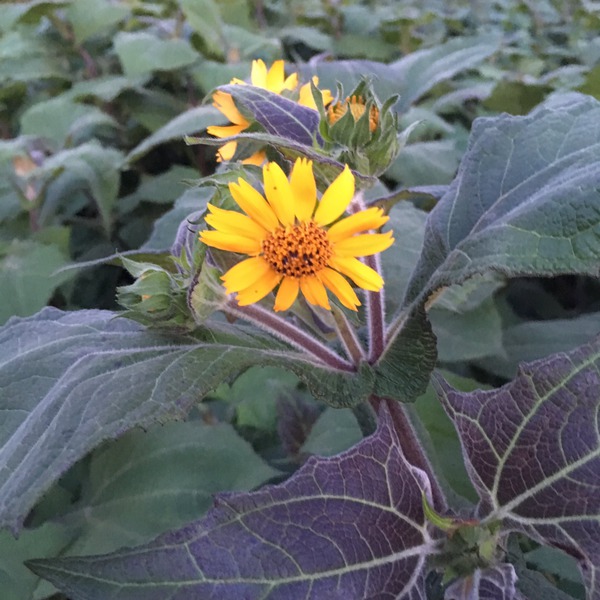
Picture: In the late flowering the relationship to the sunflower can be seen well
Yacon – origin and winter hardiness
The original distribution area of the yacon (Smallanthus sonchifolius – also known as Peruvian ground apple) is the eastern slopes of the Andes, where it is warmer and more humid than on the western slopes. The Incas already cultivated these plants and used the tubers as a healthy source of sap, juice and refreshments. At the end of the 19th century, the first yacon plants arrived in Germany.
In Europe, yacon is not hardy and therefore must be grown as an annual crop. The cultivation and care are most comparable with a dahlia. With the first night frosts in autumn, the leaves and the herbaceous shoots die. After that, the tubers should be harvested promptly, as they cannot tolerate any frost and grow quite densely below the surface.
Yacon – location and cultivation requirements
In terms of location, a site in full sun should be chosen. Unlike other tuberous vegetables of the Andean region (especially oca), the yacon tolerates significantly higher temperatures in Europe and also copes better with dry periods. Nevertheless, for optimal development of the edible storage tubers, a sufficient water supply should be ensured. Since the fresh leaves of the yacon are particularly sensitive to frost, it should only be planted when the danger of late frost has passed in the spring. For optimum yield, yacon plants require at least five months of growth. Thus, if planted in mid-May, harvesting should not begin until late October at the earliest, provided the above-ground plant parts are still active or not yet permanently damaged by night frosts.
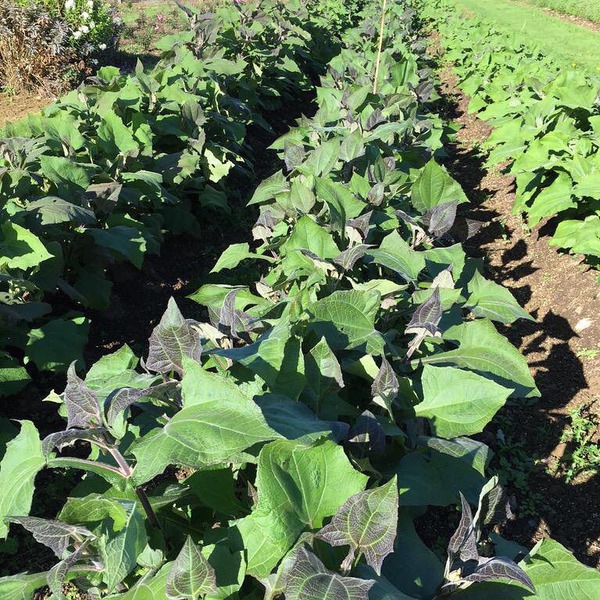
Picture: Yacon as row crop
What does yacon taste like?
Freshly harvested yacon tubers have a fruity, sweet taste. Occasionally, the taste is also described as a mildly sweet celery flavour. The sweetness is due to the fructooligosaccharide content. As the tubers are stored, these fructooligosaccharides are broken down over time to fructose and glucose, causing the tubers to become significantly sweeter as time goes on. The same effect is achieved when the tubers are left in the sun for a few days immediately after they are harvested.
Yacon tubers can be eaten both raw and cooked. The easiest way to prepare them is to peel the tubers and eat them raw, like fruit. The raw tubers have a crunchy, firm, but also juicy texture. Yacon is also often used to make juices or blended smoothies. The firm bite and a distinct crunchiness are largely retained even when cooked.
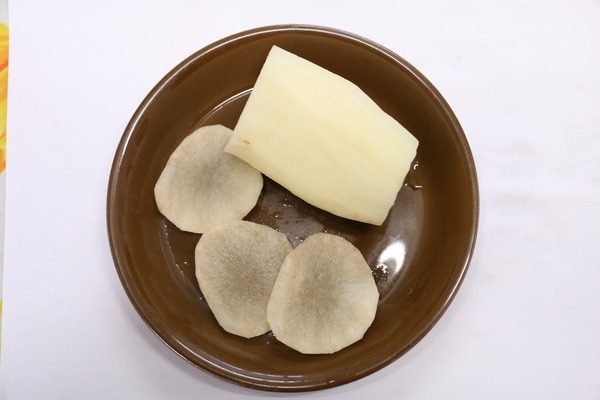
Picture: raw and peeled Yacon tubes
However you use yacon (Smallanthus), the characteristic sweet basic taste will always remain, which can then be balanced and countered with spices or also be enhanced to desserts.
Benefits for the consumer
In addition to the producibility of the product for sale, the advantages for the end consumer play a decisive role for the plant producer, but also for the retailer. Especially if you want to introduce a new product, the advantages for the end consumer must be crystal clear – otherwise you can never sell successfully. That is why we have compiled the most important advantages of the yacon for the end consumer, i.e. the hobby gardener.
- Yacon tubers can be eaten both raw and cooked; there are many uses in both sweet and savoury dishes
- Yacon plants do not have great demands on the soil or location
- Only low susceptibility to diseases
- High yields/huge tubers with low maintenance; ideally more than 10 kg per plant can be harvested
- Tall growing; can also be used in the garden as a temporary border/visual screen, or for mixed crops with shade-loving plants (e.g. in alternation with oca)
Tips for successful cultivation
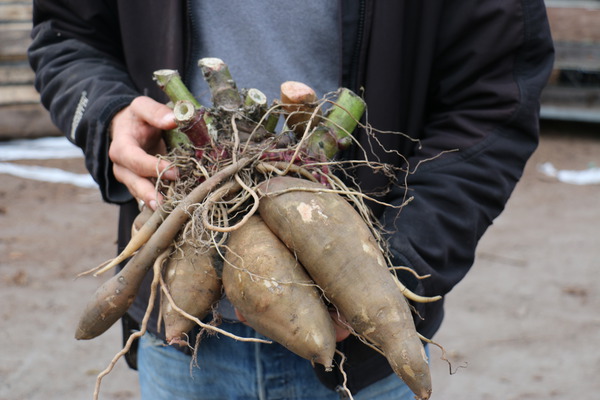
Picture: giant yield is possible, with more than 10 kg per plant
To ensure that the end consumer can also achieve the highest possible yield, we have compiled the most important tips for cultivation for you below:
- Choose a full sun location
- Pay attention to only moderate nitrogen application, otherwise the plant growth will be at the expense of the formation of the tubers
- Plant only when the danger of late frost has passed, from mid-May onwards
- Harvest as late as possible, the plants need at least five months of growth for a significant yield
- Harvest the yacon tubers before the ground too deep
- Storage will result in sweeter tubers; at a temperature of 10°C and increased humidity (75 - 85%), the tubers can be stored for up to four months; at only 2°C, the tubers can also be stored for up to a year
Yacon – the sweet tubers are the effort/yield champions in the vegetable assortment
As described above, yacon is also a tuber vegetable crop that is relatively easy and uncomplicated to grow in the home garden and it provides the end consumer with a gigantic harvest with very little effort. It is perfect for smart, lazy gardeners, but also for novice gardeners who are assured success. Based on this reasoning alone (you get a lot for almost nothing, and even with little effort), the yacon should not be missing in any vegetable plant assortment: yacon are effort/yield champions in the garden. In addition, the simple production of saleable/tradable plants also speaks for the inclusion of the yacon in the assortment of tuber vegetables.
More yacon articles
Please read the following article and learn everything about the yacon young plant assortment we offer. You can produce a high-quality yacon plant for sale or trade from our yacon young plants with quite simple means in a short time.
Yacon young plants for retailers
And here you can find more articles about our 'Fruits of the roots®' assortment!
